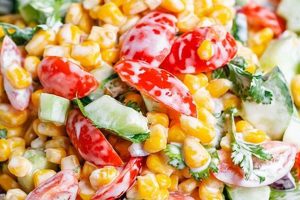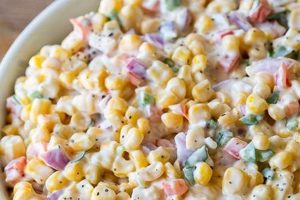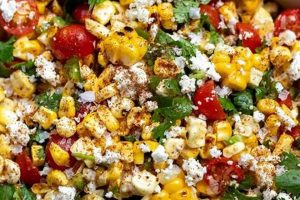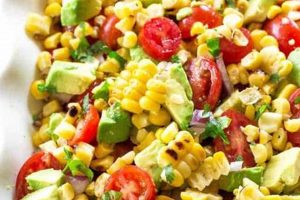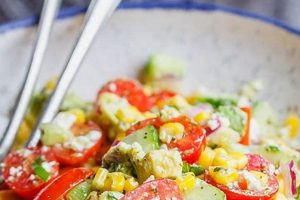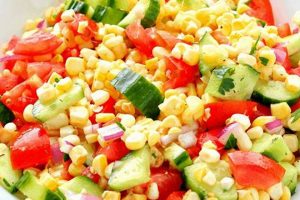Fresh, vibrant, and quick to prepare, dishes featuring corn as a central ingredient in a salad offer a delightful culinary experience. These salads can range from simple combinations of corn kernels, other vegetables, and a light vinaigrette, to more complex creations involving grilled corn, beans, herbs, and diverse dressings. For instance, a basic version might include sweetcorn, chopped red onion, bell pepper, and a lemon-herb dressing.
Such recipes offer numerous advantages. They are often budget-friendly, relying on readily available ingredients. The inherent sweetness of corn complements a wide range of flavors, allowing for versatile pairings with other vegetables, proteins, and cheeses. Furthermore, these salads are typically low in calories and fat while providing essential vitamins, minerals, and fiber. Historically, corn has been a staple food in many cultures, and its incorporation into refreshing salads represents a contemporary adaptation of traditional culinary practices.
This exploration will delve into various aspects of creating these simple yet satisfying dishes, including selecting the freshest produce, mastering fundamental techniques, and exploring diverse flavor profiles to elevate the humble corn salad to a culinary masterpiece.
Tips for Simple Corn Salads
Creating a delicious corn salad requires attention to a few key details. The following tips offer guidance for achieving optimal flavor and texture.
Tip 1: Corn Selection is Key: Opt for fresh corn on the cob when possible. The kernels will be plump and juicy, contributing significantly to the overall quality of the salad. Frozen corn can be substituted, but ensure it’s thawed completely and drained thoroughly before use.
Tip 2: Enhance with Complementary Flavors: Tomatoes, cucumbers, bell peppers, and red onion provide classic pairings with corn. Experiment with other vegetables like avocado, black beans, or zucchini for added texture and nutritional value.
Tip 3: Elevate with Herbs: Fresh herbs add brightness and depth. Cilantro, parsley, basil, and chives are excellent choices. Consider adding chopped mint for a refreshing twist.
Tip 4: Dressings Make a Difference: A simple vinaigrette is often the best choice. Combine olive oil, lemon juice or vinegar, and seasonings like salt, pepper, and a touch of Dijon mustard. Experiment with different oils and vinegars to create unique flavor profiles.
Tip 5: Grilled Corn Adds Depth: Grilling corn kernels intensifies their sweetness and imparts a smoky flavor. Grill the corn directly on the cob or remove the kernels and grill them in a pan until slightly charred.
Tip 6: Balance Sweetness and Acidity: The natural sweetness of corn benefits from a balancing acidity. Lime juice, red wine vinegar, or a splash of apple cider vinegar can provide the necessary counterpoint.
Tip 7: Seasoning is Crucial: Don’t underestimate the importance of proper seasoning. Salt and freshly ground black pepper are essential. A pinch of chili flakes can add a touch of heat.
By following these tips, one can create a simple yet flavorful corn salad suitable for any occasion. These straightforward techniques allow for a range of possibilities, from light and refreshing side dishes to more substantial and satisfying meals.
By understanding these core principles, preparing a successful corn salad becomes a straightforward and rewarding culinary endeavor.
1. Fresh, High-Quality Corn
The foundation of any successful simple corn salad rests upon the quality of the corn itself. Fresh, high-quality corn possesses a natural sweetness and tender texture that elevates the overall dish. This inherent sweetness reduces the need for excessive added sugars in dressings, aligning with the “easy” aspect of these recipes. The crisp, juicy kernels provide a pleasant textural contrast to other salad components. Conversely, using subpar corn, such as older ears or those improperly stored, can result in a starchy, bland salad, regardless of other high-quality ingredients. For example, a salad made with fresh, in-season corn will have a vibrant flavor profile compared to one made with out-of-season or poorly handled corn.
The impact of fresh corn extends beyond taste. Preparation time is significantly reduced. Shucking fresh corn is a quick process, and the kernels require minimal cooking, often just a brief blanching or grilling. This aligns perfectly with the desire for easy recipes. Furthermore, fresh corn contributes visual appeal. Bright, plump kernels add vibrancy to the salad, enhancing its overall presentation. Consider a scenario where canned corn is substituted: the resulting salad may appear dull and lack the textural appeal offered by fresh kernels. This difference underscores the importance of ingredient selection in achieving both ease of preparation and a desirable outcome.
In summary, the utilization of fresh, high-quality corn is paramount in achieving both flavor and simplicity in corn salad recipes. It reduces the need for extensive seasoning or complex cooking techniques, contributing directly to the “easy” factor. While other ingredients and preparation methods play a role, the quality of the corn establishes the baseline for the overall sensory experience. Overlooking this critical element can compromise the entire dish, regardless of other efforts. Therefore, prioritizing fresh, high-quality corn represents a fundamental step in creating a successful and satisfying easy corn salad.
2. Complementary Ingredients
The success of easy corn salad recipes hinges significantly on the thoughtful selection of complementary ingredients. These additions provide textural contrast, enhance the flavor profile, and contribute to the nutritional value of the dish. While corn’s inherent sweetness offers a pleasant base, incorporating other components elevates the salad from simple to exceptional.
- Textural Variety
Corn kernels offer a distinct texture, but relying solely on this can lead to a monotonous eating experience. Incorporating ingredients that provide contrasting textures, such as crunchy vegetables or creamy cheeses, creates a more dynamic and satisfying salad. Examples include diced bell peppers, chopped cucumbers, crumbled feta cheese, or sliced avocado. These additions prevent textural homogeneity and contribute to a more enjoyable culinary experience.
- Flavor Enhancement
Corn’s sweetness pairs well with a variety of flavors. Adding ingredients with acidity, like tomatoes or a citrus vinaigrette, balances the sweetness and prevents the salad from becoming cloying. Salty elements, such as crumbled bacon or cotija cheese, provide another layer of flavor complexity. Herbs and spices, such as cilantro, basil, or chili powder, introduce aromatic notes and further enhance the overall flavor profile. The judicious combination of these flavor elements transforms a basic corn salad into a multifaceted culinary creation.
- Nutritional Balance
While corn provides certain nutrients, incorporating complementary ingredients enhances the nutritional value of the salad. Adding leafy greens, such as spinach or arugula, boosts vitamin and mineral content. Legumes, like black beans or chickpeas, contribute protein and fiber. The inclusion of healthy fats, through ingredients like avocado or nuts, increases the salad’s satiety and nutritional density. This approach transforms a simple side dish into a more complete and nourishing meal option.
- Ease of Preparation
The principle of “easy” extends to the complementary ingredients as well. Choosing components that require minimal preparation, such as pre-washed greens, canned beans, or readily available vegetables, aligns with the overall goal of simplicity. For example, using cherry tomatoes instead of larger tomatoes eliminates the need for chopping, further streamlining the preparation process. This focus on readily available and easily incorporated ingredients underscores the convenience of these recipes.
The careful consideration of complementary ingredients is crucial for maximizing the flavor, texture, and nutritional value of easy corn salads. By strategically combining elements that complement corn’s natural characteristics, one can create a simple yet satisfying dish that appeals to both the palate and the pursuit of culinary efficiency.
3. Flavorful Dressings
Flavorful dressings play a pivotal role in elevating simple corn salads from basic to exceptional. The inherent sweetness of corn provides a neutral canvas that benefits significantly from the complexity and vibrancy offered by a well-chosen dressing. A thoughtfully crafted dressing acts as a unifying element, binding the various components of the salad together and creating a cohesive flavor profile. The interplay between the dressing and the other ingredients is crucial; the dressing should complement, not overpower, the inherent flavors of the corn and other vegetables. For instance, a bright, citrus-based vinaigrette enhances the sweetness of corn while providing a refreshing counterpoint. Conversely, a heavy, creamy dressing might mask the delicate flavors of the salad.
The “easy” aspect of corn salad recipes is further emphasized by the simplicity of creating flavorful dressings. Many delicious dressings require only a few readily available ingredients and minimal preparation time. A classic vinaigrette, for example, consists of a simple emulsion of oil, vinegar, and seasonings. Variations can be achieved by incorporating different types of oil and vinegar, such as olive oil, avocado oil, red wine vinegar, or balsamic vinegar. Fresh herbs, spices, and aromatics, like garlic, ginger, or Dijon mustard, add further depth and complexity without requiring extensive preparation. This ease of creation aligns perfectly with the overall goal of simple, accessible recipes. A honey-lime dressing, for instance, requires only honey, lime juice, and a pinch of salt, yet it imparts a vibrant and complex flavor profile to a corn salad.
The strategic use of flavorful dressings elevates simple corn salads by providing depth, complexity, and balance. The simplicity of creating these dressings contributes to the ease and accessibility of the recipes, making them an ideal choice for quick and flavorful meals. Understanding this connection allows for the creation of a diverse range of corn salads, each with its unique character and appeal. Challenges may arise in balancing flavor intensity, ensuring the dressing complements rather than overwhelms the other ingredients. However, through careful consideration of flavor pairings and a focus on fresh, high-quality ingredients, one can consistently create delicious and easy corn salads that highlight the versatility and appeal of this simple dish.
4. Simple Preparation Techniques
The hallmark of “corn salad recipes easy” lies in their straightforward preparation methods. Minimizing complex procedures and emphasizing accessibility ensures these recipes remain convenient and enjoyable for a wide range of culinary skill levels. Efficiency in preparation is key, allowing for quick creation of flavorful and satisfying dishes without demanding extensive time or specialized equipment. This focus on simplicity directly contributes to the appeal of these recipes, making them suitable for everyday meals, casual gatherings, or even last-minute additions to more elaborate menus.
- Minimal Cooking Required
Many corn salad recipes require little to no cooking, further enhancing their ease of preparation. Fresh corn kernels can be used raw, capitalizing on their natural sweetness and crisp texture. When cooking is desired, a brief blanching or grilling enhances the corn’s flavor without demanding extensive time or attention. This minimal reliance on cooking streamlines the process and reduces overall preparation time, aligning perfectly with the concept of “easy” recipes. For instance, a salad featuring raw corn, chopped bell peppers, and a pre-made vinaigrette requires no cooking whatsoever.
- Basic Knife Skills Suffice
Most corn salad recipes necessitate only basic knife skills, making them accessible to cooks of all levels. Chopping vegetables, dicing herbs, and slicing other ingredients are typically the most demanding techniques involved. This reliance on fundamental knife work eliminates the need for specialized cutting techniques or complex procedures, ensuring the recipes remain straightforward and approachable. A simple corn and avocado salad, for example, requires only dicing the avocado and slicing a red onion.
- readily available Ingredients
Easy corn salad recipes frequently rely on readily available ingredients, contributing to their convenience and accessibility. Common pantry staples, such as canned beans, and readily available produce, like tomatoes, cucumbers, and onions, are often incorporated. This reduces the need for specialized ingredients or trips to specialty stores, further emphasizing the simplicity and ease of these recipes. A classic corn and black bean salad, for instance, utilizes readily available canned black beans.
- Adaptability and Versatility
Simple preparation techniques offer significant adaptability. Corn salad recipes can be easily adjusted to accommodate available ingredients and personal preferences. Substituting vegetables, altering dressings, or adding protein elements, such as grilled chicken or chickpeas, allow for customization without sacrificing simplicity. This adaptability makes these recipes incredibly versatile, suitable for a wide range of occasions and dietary needs. A basic corn salad can be transformed into a more substantial meal by adding grilled shrimp or tofu, showcasing its adaptability.
The emphasis on simple preparation techniques is fundamental to the concept of “corn salad recipes easy.” By minimizing cooking time, relying on basic knife skills, utilizing readily available ingredients, and offering adaptability, these recipes remain accessible and enjoyable for a broad audience. This streamlined approach underscores the convenience and appeal of corn salads, making them a versatile and satisfying option for various culinary scenarios.
5. Versatile Serving Options
The versatility of corn salad extends beyond its simple preparation; its adaptability across diverse serving scenarios contributes significantly to its appeal within the context of “corn salad recipes easy.” This adaptability simplifies meal planning and allows for seamless integration into various culinary contexts, further emphasizing the convenience and practicality of these recipes. From light lunches to substantial dinner accompaniments, corn salad’s flexible nature enhances its value as a culinary staple.
- Standalone Light Meal
Corn salad’s refreshing and flavorful profile makes it an ideal standalone light meal. Its inherent nutritional value, combined with potential additions such as grilled chicken or chickpeas, provides a balanced and satisfying option for lunch or a light dinner. This eliminates the need for extensive meal preparation, aligning perfectly with the “easy” aspect of these recipes. A simple corn and avocado salad with a light vinaigrette, for example, offers a complete and refreshing meal without requiring extensive cooking or preparation.
- Side Dish Complement
Corn salad functions exceptionally well as a side dish, complementing a wide range of main courses. Its vibrant colors and fresh flavors provide a counterpoint to richer, heavier dishes, creating a balanced and appealing meal. Whether served alongside grilled meats, roasted vegetables, or hearty casseroles, corn salad adds a refreshing element to the overall dining experience. Its adaptability in this context underscores its versatility and convenience. For example, a grilled corn salad with black beans and a lime dressing complements grilled fish or chicken perfectly.
- Potluck Contribution
The ease of transport and serving makes corn salad an ideal contribution to potlucks or picnics. Its robust nature allows it to hold up well in transport, and its refreshing qualities are particularly welcome in outdoor settings. This portability, coupled with its generally broad appeal, makes it a reliable and convenient choice for shared meals. A classic corn and tomato salad, for instance, travels well and requires no heating or special serving equipment.
- Ingredient in Larger Dishes
Beyond its role as a standalone dish or side, corn salad can be incorporated into larger culinary creations. It can serve as a filling for tacos or wraps, adding texture and flavor. It can also be used as a topping for grilled meats or fish, enhancing their flavor profile with a fresh and vibrant element. This adaptability demonstrates the versatility of corn salad and expands its potential beyond traditional salad applications. For example, a southwestern corn salad with black beans, corn, and avocado can be used as a filling for tacos or burritos.
The versatility of corn salad as a standalone meal, side dish, potluck contribution, and ingredient in larger dishes underscores its value within the framework of “corn salad recipes easy.” This adaptability simplifies meal planning and expands culinary possibilities, reinforcing the convenience and appeal of these recipes. The ability to effortlessly incorporate corn salad into various dining scenarios further solidifies its position as a practical and satisfying culinary staple.
6. Minimal Cooking Time
Minimal cooking time represents a cornerstone of “corn salad recipes easy,” directly contributing to their convenience and appeal. The inherent qualities of corn allow for its incorporation into salads with little to no cooking, significantly reducing overall preparation time. This characteristic aligns perfectly with the desire for quick, effortless meals, particularly appealing to individuals with busy schedules or those seeking culinary efficiency. The reduced cooking time translates to less energy consumption and decreased kitchen cleanup, further enhancing the “easy” aspect of these recipes. For instance, a simple salad combining raw corn kernels with chopped tomatoes, cucumbers, and a pre-made vinaigrette requires no cooking whatsoever, exemplifying the speed and simplicity achievable with these recipes. Conversely, more complex salads incorporating grilled or roasted corn still benefit from relatively short cooking times, maintaining the overall ease of preparation.
The impact of minimal cooking time extends beyond mere convenience. Preserving the natural freshness and nutritional value of the ingredients is a key benefit. Minimal heat exposure helps retain vitamins and minerals often lost during extended cooking processes. This nutritional advantage, coupled with the speed of preparation, positions corn salad as a healthy and convenient meal option. Consider a salad featuring raw corn, chopped bell peppers, and a light vinaigrette: the minimal processing preserves the crisp texture and vibrant colors of the vegetables, enhancing both the visual appeal and the nutritional content of the dish. Furthermore, the reduced cooking time minimizes the potential for overcooking, which can result in a loss of flavor and texture, particularly noticeable in delicate vegetables like corn.
The connection between minimal cooking time and “corn salad recipes easy” is fundamental. This characteristic simplifies meal preparation, conserves energy, and preserves nutritional value, directly contributing to the convenience, healthfulness, and overall appeal of these dishes. Challenges may arise when incorporating ingredients that require longer cooking times, such as grilled meats or roasted vegetables. However, strategic planning and utilization of pre-cooked or readily available components can mitigate these challenges, ensuring the overall preparation process remains aligned with the “easy” principle. Understanding this connection empowers individuals to create quick, flavorful, and nutritious meals with minimal effort, highlighting the practical significance of minimal cooking time in achieving culinary efficiency and satisfaction.
Frequently Asked Questions
This section addresses common inquiries regarding easy corn salad recipes, providing clear and concise information to facilitate successful preparation and enjoyment.
Question 1: Can frozen corn be used in easy corn salad recipes?
While fresh corn is generally preferred for its superior texture and flavor, frozen corn can be substituted. Ensure it is fully thawed and thoroughly drained before incorporating it into the salad to prevent excess moisture from diluting the dressing and compromising the overall texture.
Question 2: How can one prevent corn salad from becoming watery?
Excess moisture can result from insufficiently drained canned or frozen corn, or from watery vegetables like tomatoes. Thorough draining of all ingredients is crucial. Salting certain vegetables, such as tomatoes and cucumbers, and allowing them to drain before adding them to the salad can also help reduce excess moisture. Additionally, adding the dressing just before serving prevents the salad from becoming soggy.
Question 3: What are the best ways to store leftover corn salad?
Leftover corn salad should be stored in an airtight container in the refrigerator. It is generally best consumed within two days. The texture may soften slightly upon storage due to moisture release from the vegetables.
Question 4: Can corn salad be made ahead of time for events?
Corn salad can be prepared a few hours in advance of serving, but it is generally recommended to add the dressing just before serving to prevent the salad from becoming soggy. Storing the salad components and dressing separately allows for optimal texture and flavor retention.
Question 5: How can one adapt corn salad recipes for different dietary needs?
Corn salad’s versatility allows for easy adaptation to various dietary requirements. Vegan options can be achieved by omitting cheese or using vegan alternatives. Gluten-free versions require ensuring all ingredients, including dressings, are gluten-free. Adjusting the ingredients, such as incorporating different vegetables or protein sources, can cater to specific preferences and dietary restrictions.
Question 6: What are some creative variations on basic corn salad recipes?
Numerous variations can elevate basic corn salad recipes. Grilling or roasting the corn kernels adds a smoky depth of flavor. Incorporating different herbs, spices, or cheeses introduces complexity and variety. Adding protein elements, such as grilled chicken, shrimp, or beans, transforms the salad into a more substantial meal. Exploring different flavor profiles, such as Southwest-inspired with chili powder and lime, or Mediterranean with feta cheese and olives, provides endless culinary possibilities.
Understanding these common inquiries helps ensure the successful preparation and enjoyment of easy corn salad recipes. By addressing potential challenges and exploring creative variations, individuals can confidently create delicious and satisfying corn salads tailored to their preferences and needs.
The following section will explore a selection of specific easy corn salad recipes, providing practical examples for putting these principles into action.
Conclusion
Exploration of simple corn salad recipes reveals the accessibility and culinary potential offered by this straightforward dish. Emphasis on fresh, high-quality ingredients, combined with minimal cooking and readily available components, underscores the ease of preparation. The versatility of corn salad, adaptable as a light meal, side dish, or component within larger culinary creations, expands its practical applications. Strategic selection of complementary ingredients and flavorful dressings elevates the inherent sweetness of corn, creating a balanced and satisfying culinary experience. Furthermore, the minimal cooking time involved preserves nutritional value and contributes to the overall efficiency of these recipes.
Culinary exploration often necessitates a balance between complexity and simplicity. Corn salad recipes demonstrate that culinary satisfaction need not require intricate techniques or extensive time investment. Focusing on quality ingredients, balanced flavors, and efficient preparation methods allows for the creation of dishes that are both easy and enjoyable. The potential for creative variations within this simple framework further underscores the enduring appeal and adaptability of corn salad within the culinary landscape.

